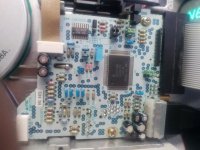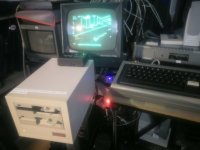LambdaMikel
Experienced Member
- Joined
- Jan 25, 2020
- Messages
- 287
Well, I knew it wasn't going to be easy, but I had to try - given the availabilty of NOS TEAC TD-55GFRs on Ebay. So I got one. Some sites (e.g., Tim Mann's TRS-80 pages) also suggest that this is a viable option. Others say they had no success with that drive at all.
I know that these are 1.2 MB, and I also figured out how to jumper them to 300 RPM.
However, I am still - at best - getting a "DISK ERROR", at worst just a blank screen (depending on the jumper settings).
I have disconnected the HD selection pin and soldered it to GND and then set the DUAL MODE / LG / I jumpers so that a low / GND on Pin 2 would force 300 RPM regardless. And that also seems to work. I also jumpered RDY instead of DC. I also tried all combinations for the remaining jumpers (E2, IU), but no success.
Well, I actually tried one of my standard 40 track SSDD disks that work in my other drive. Is it possible that I really need HD media, and maybe rewrite the disks? The DISK ERROR message is at least somewhat encouraging. I can also see the head move, so something is working.
Anybody managed to get that drive working on the Model 1? Please share how. Thanks!
https://deramp.com/downloads/floppy_drives/teac/TEAC FD-55GFR.pdf
https://retrocmp.de/fdd/teac/TEAC_FD-55_Jumper-settings.pdf
I know that these are 1.2 MB, and I also figured out how to jumper them to 300 RPM.
However, I am still - at best - getting a "DISK ERROR", at worst just a blank screen (depending on the jumper settings).
I have disconnected the HD selection pin and soldered it to GND and then set the DUAL MODE / LG / I jumpers so that a low / GND on Pin 2 would force 300 RPM regardless. And that also seems to work. I also jumpered RDY instead of DC. I also tried all combinations for the remaining jumpers (E2, IU), but no success.
Well, I actually tried one of my standard 40 track SSDD disks that work in my other drive. Is it possible that I really need HD media, and maybe rewrite the disks? The DISK ERROR message is at least somewhat encouraging. I can also see the head move, so something is working.
Anybody managed to get that drive working on the Model 1? Please share how. Thanks!
https://deramp.com/downloads/floppy_drives/teac/TEAC FD-55GFR.pdf
https://retrocmp.de/fdd/teac/TEAC_FD-55_Jumper-settings.pdf
Last edited:




